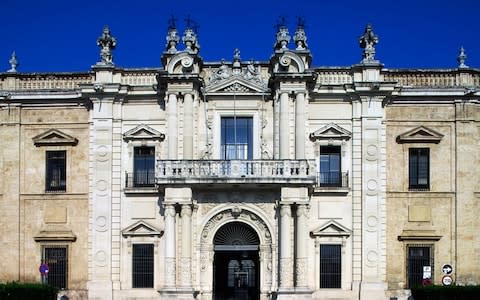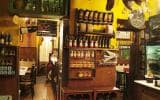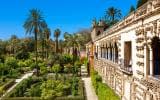9 of the best free things to do in Seville
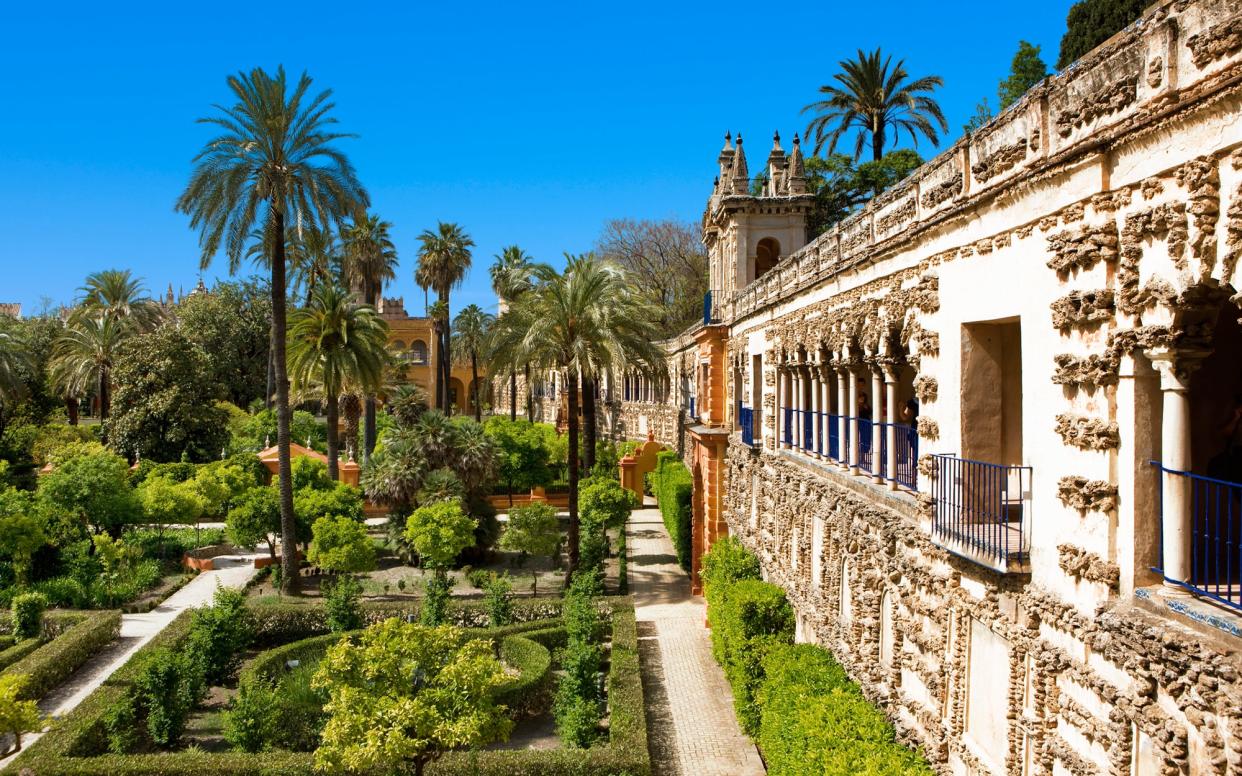
More insider guides for planning a trip to Seville
48 hours 48 hours
Hotels Hotels
Attractions Attractions
Restaurants Restaurants
Nightlife Nightlife
Free Free
One of the joys of Seville is wandering its higgledy-piggledy streets, stumbling upon tiny hidden squares with orange trees shading tiled benches. You can find plenty of ways to experience the best cultural and historical offerings the city has without spending a penny. All you need to know is where to go.
Discover the seat of the Spanish Inquisition
Centuries ago, Castillo San Jorge, the riverside medieval fortress of St George's Castle, was the most-feared building in Seville – the seat of the Spanish Inquisition, operated by the Catholic Church from 1481. Today its ruins are located underneath Triana market, and house a museum with the interesting name of the Centre of Tolerance. You can find out about day-to-day life inside the castle, and watch an animated (fictional) film about a woman who was accused of being a witch for gathering herbs (she was burned); the main targets, however, were wealthy Jews, whose land and riches were confiscated by the Crown.
Contact: 00 34 954 332 240; andalucia.org
Opening times: Tues to Sat, 10am-5.30pm; Sun, 11am-2.30pm

• The best attractions in Seville
Take a walk in the Spain’s oldest public park
Originally built as a hunting estate for Palacio San Telmo, and bequeathed to the city by María Luisa de Borbon, the eponymous Parque María Luisa was turned into a public space for the 1929 Ibero-American Expo. Wander down palm-lined avenues and under bougainvillea-swathed pergolas; explore pavilions, pools and lakes populated with ducks; quiet ceramic tiled corners with pretty fountains invite contemplation. You can also visit the (free) Popular Arts and Customs and Archaeological Museums; the former was the Mudejar Pavilion for the Expo and is a stunning mix of Moorish and Renaissance styles, while the latter has superb Roman mosaics.
Contact:visitasevilla.es
Opening times: Daily, 8am-10pm (12 midnight in summer)
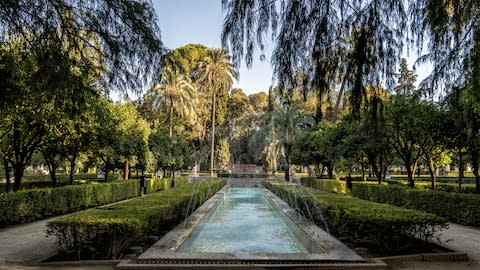
• The best free things to do in Barcelona
Travel around Spain without moving
Within María Luisa Park, facing towards the river, lies the Plaza de España. This gargantuan building with its vast plaza was the centrepiece for the 1929 Expo. Designed to display Sevillano construction and design skills, from brick-making to ceramic tile painting, its other key purpose was to welcome all-comers from newly-independent colonies to post-colonial Spain. A canal curves around the central plaza, crossed by four bridges representing the old kingdoms of Spain. Along the front of the building are tiled panels depicting the 48 provinces in Spain, each with its historical scene and map – selfie heaven for Spanish tourists.
Contact:visitasevilla.es
Opening times: Daily, 8am-10pm (12 midnight in summer)
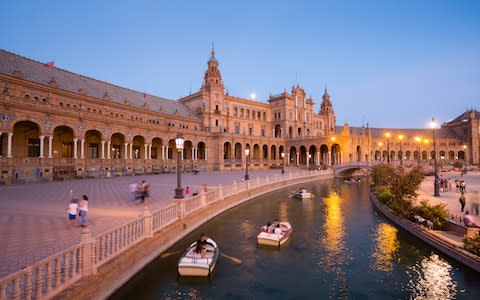
• The best things to do in Lisbon
Learn about Mudejar architecture at a palace
Escape the hustle and bustle of calle Feria at the Palace of the Marqueses de la Algaba, a 15th-century palace hidden behind Calle Feria market. Admire the Gothic-Mudejar façade, walk through the beautiful patio, and head upstairs to the Mudejar Interpretation Centre, a small exhibition in two rooms which explains about this unique style of architecture. Muslim craftsmen who stayed behind after the Reconquest used their skill and craftsmanship to create stunning artesonado decorated wood ceilings and the famous azulejos (ceramic tiles) for Catholic rulers. The intricate and ingenious geometry of their graphic designs – seemingly simple stars, with all the angles perfectly calculated – is fascinating.
Contact: 00 34 955 472 097; andalucia.org
Opening times: Mon-Sat, 10am-1.45pm; Mon-Fri, 5pm-8pm (6pm-8pm, April to October)
• Must-see attractions in Madrid
…and then visit the palaces on Mudejar Monday
Four of Seville's most emblematic Mudejar-Renaissance palaces – the Alcazar, the oldest continuously occupied European royal palace, and setting for Games of Thrones; Casa de Pilatos, home to an astonishing collection of Roman sculpture, where 1492 and Kingdom of Heaven were filmed; Palacio de la Condesa de Lebrija, with superb Roman mosaics; and Las Dueñas, as well as the Cathedral, are all free to visitors on Monday evenings.
Opening times: Mondays, around 4pm-6pm in winter; 6pm-7pm in summer.

• The best restaurants in Lisbon
Discover Columbus, ceramics and contemporary art at a monastery
A short walk from the centre, over the river Guadalquivir, is La Cartuja monastery. Founded in the 13th century, this was where Columbus planned his voyages to the New World. In the 19th century an Englishman called Charles Pickman built a ceramics factory here, and later it was restored for Expo 1992. Today it’s a contemporary art centre, with three galleries in the old monks’ cells, refectory and chapel. The gardens are pleasantly quiet, with an extraordinary Mudejar tower bearing beaded curtains from a previous art biennale. Some evenings they have live jazz, and DJs on Saturdays in summer.
Contact: 00 34 955 037 070; juntadeandalucia.es
Opening times: Tues to Sat, 11am-9pm; Sun, 10am-3pm (Free: Tues to Fri, 7-9pm and all day Sat)

• The best clubs and theatres in the Spanish capital
Watch free flamenco in a converted coal factory
The unassuming La Carbonería is one of the best places to watch free flamenco in Seville. This converted coal factory in the quieter part of Santa Cruz has three live performances every night from 9.30pm, as well as poetry readings, film screenings, art exhibitions and other cultural events. The room is large, with a wide stage facing long tables and benches, often filled with lively groups. For a more focused audience, go to one of the scheduled evening shows, but for an entertaining few hours of singing and dancing gratis, La Carbonería is a great option. When gets hot in summer, cool off in the small patio.
Contact: 00 34 954 229 945; lacarbonerialevies.blogspot.com
Opening times: Daily, 7pm to 2am

• The best restaurants in Seville
See where fashion and religion meet at one of Spain’s best fine art museums
Considered Spain’s second-most important fine art museum after the Prado, with works covering six centuries, the Museo de Bellas Artes is heaven for lovers of Golden Age Spanish baroque. Be dazzled by Zurbaran’s saints such as Santa Dorotea, with his signature rich colours and fabrics, and admire the charming spontaneity of Virgen de la Servilleta by Murillo. More recent works in the converted 16th-century convent, with beautiful patios and tiled panels, include Las Cigarreras by Gonzalo Bilbao, showing us the cigarette girls in Seville’s tobacco factory, while Valeriano Becquer’s portrait of his brother, the romantic poet Gustavo Adolfo Becquer, is an emotionally charged masterpiece.
Contact: 00 34 955 542 942; museosdeandalucia.es
Opening times: Tues-Sat, 9am-9pm; Sun, 9am-3pm

• The best restaurants in Madrid
Find your inner Carmen while wandering round a former factory
When the Royal Tobacco Factory opened in 1758, it was the first in Europe, and the second-biggest building in Spain, after El Escorial. Previous factories around the city – including in Triana, then a tough working-class neighbourhood – were amalgamated into one huge building employing up to 6,000 people, complete with its own chapel and prison. Women made the cigars and cigarettes (nimbler-fingered, better disciplined, and cheaper paid than men), including gypsies from Triana – the inspiration for Carmen, Bizet’s fiery heroine. Today it’s part of the university, and you can wander through its patios humming Toreador.
Contact: 00 34 954 551 123; institucional.us.es
Opening times: General entry: Mon-Fri, 8am-9pm; Sat, 9.30am-2pm. Free tours: Mon-Thurs at 11am
